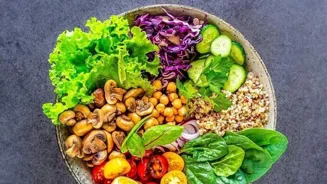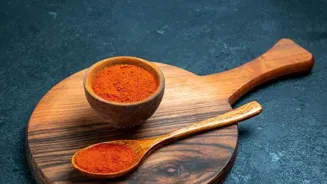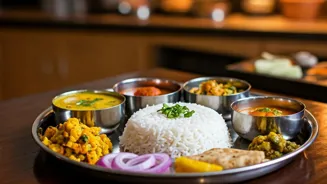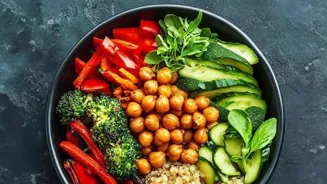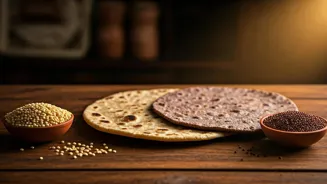Unveiling strategies to conquer food cravings in Indian cuisine! Dive in for a journey of self-discovery and delicious control
In the vibrant tapestry of Indian life, where food is not just sustenance but
an emotion, battling food cravings can feel like an everyday wrestling match.
We've all been there – that irresistible urge for a plate of piping hot jalebis, a mountain of samosas, or a comforting bowl of kheer, even when our stomachs are perfectly content.
These cravings can derail even the most disciplined eaters, leading to guilt, frustration, and a general feeling of being out of control. But fret not, fellow food lovers! Navigating these cravings is entirely possible.
It's about understanding their root cause and arming ourselves with effective strategies to manage them without sacrificing the joy of eating. This article unveils ten practical tips to help you conquer those cravings and maintain a healthy relationship with food.
From mindful eating practices to clever substitutions and lifestyle adjustments, we'll explore how to take charge of your cravings and achieve your wellness goals, all while savoring the deliciousness that Indian cuisine has to offer.
Get ready to embark on a journey of self-discovery and delicious control!
Understand Your Cravings: The Detective Work Begins
Before you can effectively combat food cravings, it's crucial to understand what triggers them in the first place. Cravings aren't random; they're often signals from your body or mind trying to tell you something. Are you truly hungry, or are you simply bored, stressed, or emotionally triggered?

Start by keeping a food diary, noting not just what you eat but also when and why you crave certain foods. What were you doing right before the craving hit? What emotions were you experiencing? Identifying these patterns can provide invaluable insights into the underlying causes of your cravings.
Perhaps you crave sweets after a stressful meeting, or salty snacks when you're feeling lonely. Once you pinpoint these triggers, you can begin to address the root issues instead of simply masking them with food.
This might involve finding healthier ways to manage stress, practicing relaxation techniques, or seeking support from friends, family, or a therapist. Understanding your cravings is the first step towards regaining control and making conscious food choices.
It's about becoming a detective in your own life, uncovering the mysteries behind your food desires.
Food cravings often stem from a complex interplay of physiological, psychological, and environmental factors, understanding these factors and keeping journals to understand your body is of paramount importance.
The Power of Hydration: Drink Your Way to Control
Sometimes, our bodies mistake thirst for hunger, leading to unnecessary cravings. Before reaching for that tempting treat, try drinking a glass of water. You might be surprised at how often this simple act can quell a craving.

Water helps to fill your stomach, signaling to your brain that you're not actually hungry. Staying adequately hydrated also supports overall bodily functions, which can indirectly help to regulate appetite and cravings. Keep a water bottle with you throughout the day and sip on it regularly.
You can also infuse your water with fruits like cucumber, lemon, or mint for added flavor and refreshment. Herbal teas can also be a great way to stay hydrated and satisfy cravings for something warm and comforting. Experiment with different flavors and find what you enjoy.
Adequate hydration can transform your experience and assist you in tackling food cravings.
The importance of staying hydrated cannot be over stated. Hydration also contributes to feeling full thereby making you consume fewer calories.
Fiber is Your Friend: The Filling Powerhouse
Incorporating more fiber into your diet can significantly reduce cravings and help you feel fuller for longer. Fiber-rich foods are digested slowly, preventing rapid spikes and crashes in blood sugar levels, which can trigger cravings.
Load up on fruits, vegetables, and whole grains like oats, brown rice, and quinoa. Lentils and beans are also excellent sources of fiber and protein, making them a satisfying and nutritious addition to your meals. Aim for a variety of fiber-rich foods to ensure you're getting a range of nutrients.
Start your day with a bowl of oatmeal topped with berries and nuts, or add a side of steamed vegetables to your lunch and dinner. When you feel a craving coming on, reach for a piece of fruit or a handful of raw vegetables instead of processed snacks.
Fiber is a powerful tool in the fight against cravings, helping you stay satisfied, regulate blood sugar, and maintain a healthy weight.
Consumption of fiber rich foods ensures that you are complete and don't get frequent cravings.
Protein Power: The Craving Crusher
Protein is another essential nutrient for managing cravings. Like fiber, protein helps to keep you feeling full and satisfied, preventing those mid-afternoon slumps and late-night cravings. Include a source of protein in every meal and snack.
Good sources of vegetarian protein include lentils, beans, chickpeas, tofu, paneer (Indian cheese), and nuts. Greek yogurt is another excellent option, as it's packed with protein and can be enjoyed in a variety of ways. Add protein powder to your smoothies or oatmeal for an extra boost.
When you're feeling a craving, try snacking on a handful of nuts or a hard-boiled egg. Protein helps to stabilize blood sugar levels and reduce the release of hunger hormones, making it easier to resist temptation.
By prioritizing protein in your diet, you'll not only feel more satisfied but also have more energy throughout the day. Protein rich foods work wonders and are highly recommended for food cravings.
Adding protein to your diet ensures you feel full and also helps in building muscle.
Mindful Eating: Savor the Moment
In our fast-paced world, it's easy to eat meals on autopilot, barely registering what we're consuming. This can lead to overeating and a disconnect from our body's hunger and fullness cues.

Mindful eating involves paying attention to the present moment while you eat, focusing on the taste, texture, and smell of your food. Eliminate distractions like your phone, TV, or computer, and sit down at a table to enjoy your meal. Chew your food thoroughly and savor each bite.
Notice the colors, aromas, and flavors. Ask yourself if you're truly hungry, or if you're eating out of boredom or habit. Slowing down and paying attention to your food can help you recognize when you're full and prevent overeating.
Mindful eating isn't about restricting what you eat; it's about developing a healthier relationship with food and learning to listen to your body's cues.
Mindful eating will help you understand your body and also help you to decide when to stop eating.
This brings a more healthy relationship with food.
The 80/20 Rule: Indulge Without the Guilt
Completely restricting your favorite foods can backfire, leading to intense cravings and feelings of deprivation. Instead of trying to eliminate all "unhealthy" foods from your diet, adopt the 80/20 rule.
This means that 80% of the time, you focus on eating nutritious, whole foods, while the remaining 20% is reserved for indulging in your favorite treats in moderation. This approach allows you to enjoy the foods you love without feeling guilty or deprived.
When a craving hits, allow yourself a small portion of the desired food, but be mindful of your portions. Savor each bite and enjoy the experience.
By allowing yourself occasional indulgences, you're less likely to feel restricted and more likely to stick to your healthy eating habits in the long run.
It is very important to understand that it is okay to indulge once in a while.
The 80/20 rule teaches us to have control over our consumption and make sure we do not give up totally.
Find Healthy Substitutions: The Swapping Game
Sometimes, a craving isn't about a specific food but rather a general taste or texture. For example, if you're craving something sweet, try reaching for a piece of fruit instead of a sugary treat. If you're craving something crunchy, opt for a handful of nuts or seeds instead of chips.
Experiment with different healthy substitutions to satisfy your cravings without derailing your diet. You can also try making healthier versions of your favorite treats using wholesome ingredients.
For example, you can bake your own cookies using whole wheat flour, oats, and natural sweeteners like honey or maple syrup. Get creative in the kitchen and explore new recipes that satisfy your cravings in a healthy way. You can always swap for a healthier version of your favorite food.
Explore your options regarding healthy sub categories and make your choice.
Distract and Divert: The Craving Interrupter
When a craving hits, don't dwell on it. The more you think about it, the stronger it will become. Instead, try to distract yourself with an activity you enjoy. Go for a walk, listen to music, read a book, call a friend, or engage in a hobby.
Anything that takes your mind off the craving can be effective. Physical activity is particularly helpful, as it releases endorphins, which can improve your mood and reduce stress. Even a short burst of exercise can help to curb a craving.
The goal is to interrupt the craving cycle and give yourself time to regain control. This is a very effective way and recommended by many people.
Distracting yourself is the best way to divert from your cravings and it works most times.
Stress Management Techniques: Calming the Chaos
Stress is a major trigger for food cravings. When you're stressed, your body releases cortisol, a hormone that can increase your appetite and make you crave sugary and fatty foods. Finding healthy ways to manage stress can significantly reduce cravings.

Practice relaxation techniques like deep breathing, meditation, or yoga. Spend time in nature, listen to calming music, or take a warm bath. Identify your stress triggers and develop strategies for coping with them. If you're feeling overwhelmed, talk to a friend, family member, or therapist.
Taking care of your mental and emotional well-being is essential for controlling cravings and maintaining a healthy relationship with food. This is a great way to release stress and be free of food cravings.
Taking care of your mental and emotional well-being is very important and helps in reducing cravings.
Patience and Persistence: The Long Game
Conquering food cravings is a journey, not a destination. There will be times when you slip up and give in to a craving. Don't beat yourself up about it. Instead, learn from the experience and move on. Remember that progress, not perfection, is the goal.

Be patient with yourself and celebrate your successes along the way. It takes time to develop new habits and change your relationship with food. Keep practicing these strategies and don't give up on yourself.
With patience and persistence, you can conquer your cravings and achieve your wellness goals.
Do not get disheartened if you give in to the craving once in a while. Learn from it and move on. This is a slow process so be patient and success will be yours.

